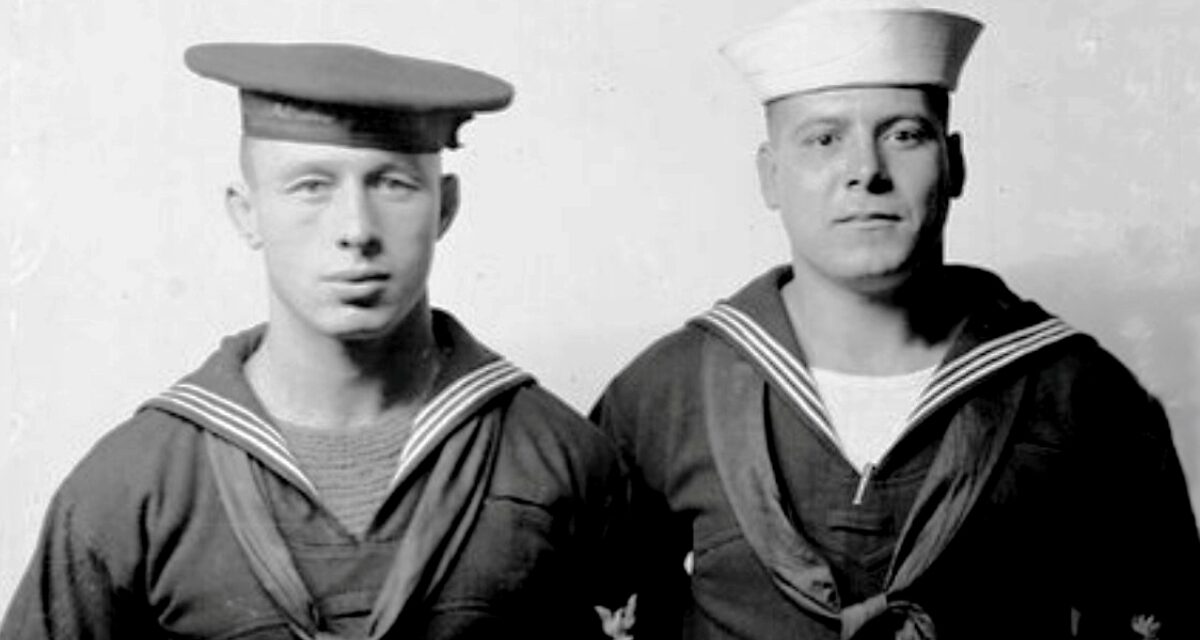Ben Reuben was a satisfied man when he ducked into an air transport plane on March 3, 1945. He was in his second world war and wrestling, his great passion, had seen him through both conflicts — first, as a fresh-faced kid of 22 teaching men 10 and 15 years older how to fight hand to hand with Kaiser Wilhelm’s soldiers, and now, approaching middle age, managing a tour of pro wrestlers to entertain troops in the European theater.
The first leg of the tour in England had gone well and Reuben’s lone problem seemed to be squeezing a wrestling mat on a United Service Organizations plane overloaded with passengers. To lessen the plane’s payload, junior heavyweight star Al Williams agreed to hop on a later flight and soon Reuben and five wrestlers were on a short jaunt across the English Channel to showcase their skills in France.
Then the plane fell from the sky.
Nearly 80 years later, it’s still unclear what caused the single greatest loss of life in pro wrestling history — six stars of the mat along with 10 others aboard the USO plane. A statement from the U.S. War Department simply hailed the exceptional service record of the transport command fleet, saying the accident marred a perfect record of 5 million flight-miles without a fatality. But though V-E Day was just three months away, German V2 rockets were still striking London in March 1945, so there always will be a cloud of suspicion about Ben Reuben’s final flight.
Which is hardly the way to remember him.
“Benny’s performances and his triumphs did more than any other one thing to get Jewish kids in Chicago participating in sports,” said sportswriter Herb Graffis. “Benny was never any part of a minority to me. He was among the leaders of America’s majority of on-the-level guys.”
OUT OF NOWHERE
There was no particular reason to believe the scrawny, 14-year-old who walked on to the wrestling team at the Chicago Hebrew Institute was a prodigy. But like Mozart with music or Bobby Fischer with a chessboard, Ben Reuben Jr. was gifted from the start. The son of Russian-Jewish immigrants who settled in Chicago in 1888, Reuben was just 120 pounds when he joined the institute’s team in 1909.
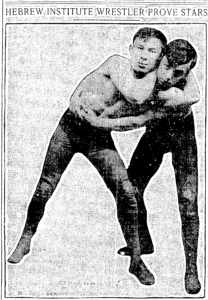
Ben Reuben (r) in a 1913 image from the Chicago Daily News.
Elusive and lightning-quick, he was tossing opponents within weeks to the point that the Chicago Daily News took note of the way he made “such rapid progress in learning all the fine points of the game.” In February 1910, he won his first junior title as the 128-pound champion of the International Gymnastic Union, a competition of 100 wrestlers held in Chicago, the hotbed of U.S. wrestling.
In 1911 and 1912, he captured the 135-pound senior class in both the IGU and Amateur Athletic Federation meets, following up as an 18-year-old with an unheard-of sweep — the 135-pound national Amateur Athletic Union title, the 145-pound AAF crown and the Illinois Athletic Club welterweight title. In 1912 and 1913, he led the Hebrew Institute teams to first-place finishes in the IGU and AAF tourneys.
The Chicago Daily News called him “the sensation of the last two seasons in the Chicago amateur ranks” and compared him to the legendary Fred Beell, the first pro wrestler to hold middleweight, light-heavyweight and heavyweight titles at the same time. Gifted by supporters with a trip to New Orleans, Reuben defeated the southern AAU champion three hours after he arrived in the city in 1913.
Trained by pro Ernst Kartje at the Hebrew Institute, the wiry Reuben was borderline unstoppable, combining unusual strength and an ability to slip deftly in and out of a variety of holds. In 1914, it took him three minutes to beat F.J. Walsh in Chicago for the AAU national title at 158 pounds, a crown he successfully defended in 1915 with no match exceeding 2 minutes and 15 seconds; he added another IGU middleweight trophy in February 1915.
To that point, Reuben had likely collected more titles than any amateur in the country and not once did his shoulders touch the mat. His record made the next stop inevitable — training in San Francisco for the 1916 Olympics, where he came out on top among middleweight contenders and set his sights on the games to be hosted in Berlin.
Reuben was “the king of middle-weight wrestlers,” in the view of Fred A. Marquardt of the Chicago Daily News. His successes, coupled with those of the great Earl Caddock, a friend and fellow Chicago Hebrew Institute trainee, inspired the institute to construct a dedicated, $125,000 athletic training facility.
CHANGE OF PLANS
Opponents were unable to knock Reuben off his game, but war and by-the-book bureaucrats could. World War I forced the cancellation of the Berlin games, thwarting Reuben’s hopes to represent his country on his first overseas trip.
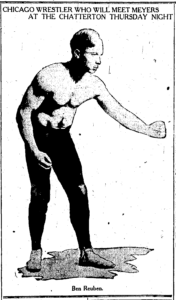
Ben Reuben just starting as a pro.
In December 1915, the Chicago-based Central AAU tagged Reuben as a pro and suspended him for participating in a match with his mentor and coach Kartje. The amateur body was unmoved when a peeved Reuben protested that he never received a cent for the exhibition and pointed to association rules that sanctioned instructor-pupil presentations.
If the AAU was going to treat him like a pro, Reuben figured he might as well benefit from it. In January 1916, a few days after he turned 21, Reuben accepted a paid post as wrestling coach for the Western Electric Athletic Association and set his aim on the pro middleweight championship, an unofficial title claimed by several combatants. “He saw no chance of finding any more real competitors in the amateur ranks,” Marquardt reasoned.
It’s no stretch to say that boxing had Muhammad Ali and Joe Frazier, soccer had Lionel Messi and Cristiano Ronaldo, and middleweight wrestling in the Midwest had Ben Reuben and Johnny Meyers of Sheboygan, Wisconsin. Their rivalry for supremacy in their weight class included at least a dozen matches across eight years, usually with some type of title claim at stake.
They first locked up in February 1916 in Reuben’s second match as a pro. He took the first fall, reportedly the first time Meyers had been pinned, but forfeited the bout when Meyers wrenched him in a hammerlock that rendered him unable to continue. Three weeks later in Springfield, a ringside doctor halted the contest because of the possibility of infection under Reuben’s left arm, where he had six boils recently lanced.
During his first year as a pro, Reuben wrestled at least 16 times, often sweeping consecutive falls, with the Meyers bouts as the only black marks on his record. He finally gave Meyers his comeuppance in January 1917 at the Virginia Theatre in Chicago, winning straight falls in a combined 50 minutes. “Perhaps no other pair of compensated middleweights admire the look of each other less than Meyers and Reuben,” the Chicago Daily News decided.
Reuben went to a two-hour draw with Mike Yokel of Utah, probably the wrestler with the best claim to a world title, then routed Meyers in back-to-back falls in March 1917. That positioned him as one of the emerging stars of the game, so much so that old friend Caddock turned to him as a training partner as he lifted the heavyweight crown from Joe Stecher in Omaha, Nebraska. When Reuben returned to knock off Walter Evans, the wrestling instructor at the University of Illinois, writer Regnis Herbert tabbed it “one of the cleanest and spiciest matches seen here in years.”
UNCLE SAM CALLS
The U.S. entered World War I in April 1917 and Reuben was quick to enlist, joining the Illinois Naval Reserve in May and on track to see duty in European waters. He had been working a day job as a mechanic and was assigned the role of machinist’s mate, second class, at the sprawling Great Lakes Naval Station north of Chicago.
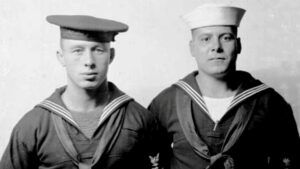
Wrestling star Ben Reuben (l) with colleague Sam Varron in 1917. Chicago Daily News collection, Chicago History Museum.
Reuben’s commanding officer saw a better use of his time. At 22, Reuben was assigned the role of instructor of wrestling; the service had to tailor a special suit to accommodate his 47-inch chest and 32-inch waist.
Working with friend and fellow wrestler Sam Varron, Reuben held classes with a core curriculum for about 50 fighting men daily — how to break a waist hold with a knee and a hand, the use of a stranglehold and a flying mare, knife protection and jiu-jitsu moves.
He put on weekly shows so his trainees could demonstrate their new knowledge in front of audiences as large as 5,000 servicemen. “As a result,” the Illinois State Register said, “more than 500 men will know how to conquer a German should hand-to-hand fighting ever occur in their sea careers.”
Reuben’s wrestling inventory consisted of two worn-out mats rotated among seven camps, so he raised money for new equipment in the logical fashion — a grudge match with Meyers that went nearly three hours without a fall. When he scored a victory against Yokel in March 1918 in Chicago, Reuben had a legitimate claim as the best middleweight in the land and one of Uncle Sam’s most successful athletic instructors.
Another match with Meyers in April 1918 proved more problematic. Reuben, now elevated to machinist’s mate, first class, injured his left knee in dropping a referee’s decision to his archrival. In July, he got his orders to go to Italy and traveled to New York to ship out.
Roughhousing with a shipmate, he aggravated the knee injury and, for the second time, lost out on a chance to go overseas. At Presbyterian Hospital in Chicago, a surgeon cleaned out and reattached torn cartilage, a process simpler today than in October 1918. Two months later, the Navy discharged its hobbled wrestling instructor.
RETURN TO SPORT
More than one commentator noted that Reuben didn’t seem to be the same wrestler after the knee operation. The record bears that out. Touring California in May 1919, he lost two of three falls to Walter Miller, another middleweight title claimant, then dropped a two-hour contest to Meyers in Chicago.
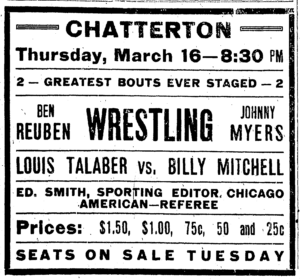 For the next four years, he wrestled mostly for Chicago promoters Joe Coffey and Doc Krone. He beat William Demetral, another top middleweight in December 1919 when Demetral could pin him only once in an hour, not twice as he avowed. The feud with Meyers effectively ended in December 1920 when Reuben lost in straight falls in Chicago; the duo combined for a nice payday though, with 5,000 fans and a gate of $8,000.
For the next four years, he wrestled mostly for Chicago promoters Joe Coffey and Doc Krone. He beat William Demetral, another top middleweight in December 1919 when Demetral could pin him only once in an hour, not twice as he avowed. The feud with Meyers effectively ended in December 1920 when Reuben lost in straight falls in Chicago; the duo combined for a nice payday though, with 5,000 fans and a gate of $8,000.
To prepare himself for life out of the ring, Reuben opened a garage on West 12th Street in Chicago, operated a nine-table billiard hall, picked up some refereeing assignments and eventually was a matchmaker for Fred Kohler at the Chicago Coliseum.
“When in his prime, Reuben couldn’t be beaten,” wrote Frank Smith of the Chicago Tribune. “He was near the uttermost top of the professional middleweight ranks when he injured one of his knees and faded out of the picture so far as serious competition was concerned.”
Wrestling on and off into the 1930s, Reuben became known as much as an instructor as an ex-champion, working with up-and-coming wrestlers at the Chicago Hebrew Institute. Sportswriter Graffis was in high school when he started to hear about Reuben’s prowess with Jewish youth. “I’ve met a lot of fellows who were taught by Benny and the Reuben influence stays with them, keeping them fine, square sportsmen and gentlemen. Benny was hell against any sort of dirty work.”
PATRIOTIC DUTY
Reuben was determined to serve his country again, one way or another. The abrupt ending to his World War I service left him unfulfilled, and, while working as a post office guard and part-time wrestling promoter and teacher, he wanted to reenlist in any way possible. Reuben “tried every way to join some branch of the service when this war broke out,” said Col. Joe Triner, chairman of the Illinois Athletic Commission and a veteran of the D-Day invasion. “I know, because I was in a position to know.”
So he turned to what he knew best — wrestling. Working with the Chicago Sun-Times and the Red Cross speakers bureau, Reuben helped organize a group of Midwest wrestlers to entertain soldiers at local hospitals and military camps.
Yugoslavian-born George Matkovich, who wrestled as George Mack, the Millionaire Milkman, was an easy choice. He and Reuben promoted together in Cicero, Illinois. Mack had been a dependable bad boy for nearly two decades, unshaven, black hair dangling in his eyes as he baited referees. “I do nuttin’ but wrastle my best. I punch the udder guy before he punches me. I dat wrong?” he rationalized to one sportswriter.
Jack Ross, Al Sabath, Lester “Kid” Chapman, Gay Young, Al Gordon and Al Williams rounded out the entourage. All but Young, a former college football player, were from the Chicago area; Young was from Minneapolis. You wouldn’t want to cross any of them on the mat, but as pros, they sure knew how to put on a show.
They repeated their performances in front of group after group, always for free, and stealing every scene they were in. When fans at Camp Grant booed Mack because he was bleeding, he shot back, “Boys, this blood I’m losing now is nothing. When the Times wanted blood donors for the Red Cross I was first in line. Now I’ve given three pints.”
The USO took note of their success and signed the group, though Gordon withdrew because of a back injury. Reuben would finally cross the Atlantic. Just before the team left U.S. soil on February 11, 1945, Reuben, 50, jokingly pinned his son Donald in a mock match as part of a variety benefit show. “If they hadn’t been pretty good in their line, they wouldn’t have been asked to make the trip,” John Carmichael wrote in the Chicago Daily News, “and if the War Department hadn’t thought the men would like to see ’em, they wouldn’t have been permitted to go.”
The crash was not reported publicly until 10 days after it occurred, which only leads to speculation about its origins, though there never has been any report to counter the finding of an accident.
The Chicago Tribune broke the news on March 14 after talking with Sabath’s widow Adelaide. The War Department confirmed it in a statement the following day and the fatalities drew headlines for a few days as the wrestlers joined 500 amateur and pro sports figures who lost their lives in wartime service. The Chicago Sentinel praised Reuben as “an example of a good, clean athlete who commanded the respect of all and served as an inspiration to all boys of every race and creed.”
Reuben was survived by his wife Sally, a British-born bookkeeper, his son, later to be a prominent libel attorney, and his mother Mary, who died in July 1945. The decedents received a military funeral in France. Individual services were held later in the U.S. and Kohler ran two benefit wrestling shows that raised about $1,700 for the victims’ families; Williams wrestled on both. For reasons never explained, Reuben’s remains were gathered but not transported to the U.S. until 1949.
Though Reuben had been out of the limelight for about 20 years, his death hit hard with a community that remembered him as a kid who came from nowhere to become the darling of wrestling fans and a man whose patriotic instincts led to his final flight. As Graffis wrote, “Knowing the kind of guy Benny was, I believe Benny figured he won the deciding fall and the title when he went to his death trying to do the best he could for kids who were sent to face death.”
TOP PHOTO: Wrestling star Ben Reuben (l) with colleague Sam Varron in 1917. Chicago Daily News collection, Chicago History Museum.
REMEMBRANCE DAY / VETERANS DAY STORIES
